Aaron Regunberg: The Terrible Cost of High-Stakes Testing
Friday, December 07, 2012
This week, a group of high school youth I work with organized a teach-in for their fellow students and their teachers on Rhode Island’s new standardized testing graduation requirement. Unsurprisingly, they did not get very far into the meeting before the discussion turned to the incredible amount of time and energy—both students’ and teachers’—that testing like this inevitably consumes as soon as high stakes are applied.
It was a great conversation, and one that would have been very enlightening to researchers at the Brookings Institute, who released a report last week claiming to analyze the amount of money being spent on standardized testing in our country. The report came up with the figure $1.7 billion, which does not sound like such a big number compared to the $600 billion we spend overall on public education.
If only this were the actual cost of standardized testing in our education system.
GET THE LATEST BREAKING NEWS HERE -- SIGN UP FOR GOLOCAL FREE DAILY EBLASTA reading of the report reveals that the $1.7 billion figure they found refers only to the money that states pay directly to test vendors to procure and score their exams. Unfortunately, such a narrow scope is basically meaningless as a measurement of the actual costs of standardized testing. The real price of testing lies in the amount of resources that they gobble up when our public policy forces schools to put extreme emphases on them. And as anyone with experience in today’s public schools knows all too well, these costs are absolutely enormous, and seem to be growing every year.
Of course, these radically larger costs are much more difficult to evaluate, but they certainly aren’t impossible to judge. As a starter, the youth-led teach-in I attended offered a great catalogue of the main measures that need to be added up make this calculation.
First of all, students at the event spoke about the excessive amount of time taken up by the simple administration of these tests every year. Most people assume that the whole process takes up just a few hours, but in reality the numerous required tests are taken over the course of multiple weeks during the school year. Each of these testing days disrupts the learning of the entire school—school days are truncated, classes are shortened, and as a result of all the distraction, very little real teaching and learning can actually take place. So all of that lost time is the first item to be tabulated.
Second, youth addressed the great deal of school time that is explicitly devoted to test preparation. One member of the group talked about how his school cancels advisory period in the weeks or months leading up to the October NECAP administration, filling that time instead with basic test prep. Others complained of classes being used to take practice tests instead of tackling new material. So that’s another load of lost time (and, consequently, resources) that needs to be added to the equation.
Third, teachers spoke about the way testing consumes so much of their day beyond the classroom, pervading planning meetings and staff development time. These periods used to be about allowing teachers to communicate with one another, to collaborate, to share information about students and improve teachers’ craft. But nowadays there’s not enough time for that—instead there are test questions that need to be analyzed, and more test questions that need to be analyzed. So we need to include all those staff hours in our total.
Fourth, teachers had a mouthful to say about the way high-stakes testing forces them to distort what happens in their classrooms. They know that they will be evaluated based on their students’ test scores. And now, with Rhode Island’s new testing graduation requirement, they know that their students’ futures depend on their test scores. For most rational teachers, this means that there’s nothing for it but to redirect a huge proportion of their classroom time to teaching to the test. This means abandoning project-based learning (and think back about your own most memorable classroom experiences—I best most of them involved projects); it means giving up on teaching to deeper levels of understanding or creativity that cannot be evaluated by standardized tests; and it means deserting the bigger issues—morality, civic responsibility, empathy, etc.—that tests do not even try to measure. It means, in short, forcing teachers to suck from schooling the vast majority of what makes an education meaningful. So let’s factor that into our hypothetical calculations, as well.
If one were to add up these major points, it would become clear what a truly vast proportion of resources standardized testing has come to consume in today’s public schools. And to what end? The current high-stakes testing regime has been in full force nationally for close to twelve years now, and where has it gotten us? Has academic achievement significantly improved? (No.) Have educational inequities been relieved? (No.) Do we really think public school students are receiving better educations now, since we started testing them to death?
No. In fact, a generation of young people continues to be robbed of the education they deserve. It is time to fundamentally rethink this reform strategy. It is not too late. But the clock is certainly ticking



